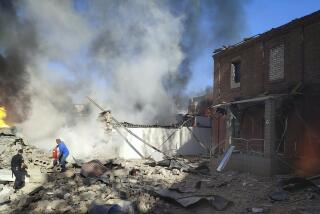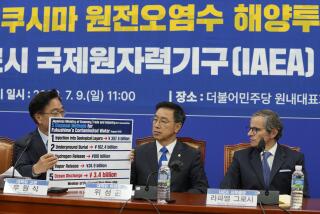U.N. Agency Plans Radiation Warnings
- Share via
VIENNA — The International Atomic Energy Agency’s board of governors will hold a special meeting here Wednesday to start setting up a global system that would give early warning of radiation releases such as occurred in the Chernobyl disaster.
Hans Blix, the Swedish director general of the agency, said Thursday that the Soviet Union will send a team of experts to Vienna in about six weeks to give a full report to nuclear engineers and safety experts from all IAEA member countries on the reactor accident.
The Soviets will be following a procedure adopted by the United States in 1979 after the nuclear plant accident at Three Mile Island near Harrisburg, Pa. After that accident, which resulted in some release of radiation but no injuries, it took about three months for officials to complete their analysis of what went wrong and how it was handled. They then spent several days in Vienna discussing their findings with the IAEA, an agency of the United Nations.
Blix, who visited Chernobyl last week along with other IAEA officials, has already called for “a multilateral convention under which members of IAEA would agree to inform each other of any radioactivity releases which might have trans-boundary effects.”
Soviet leader Mikhail S. Gorbachev added his backing for an international early-warning system in his televised address to the Soviet nation on Wednesday.
Reporting System
In effect, the IAEA hopes to set up a reporting system on radioactivity that would parallel the exchange of information from weather reporting stations around the world.
At Wednesday’s meeting, the board of governors is expected to direct the IAEA secretariat to begin drafting a treaty for consideration at a full annual general meeting of the 112 member states in September.
The Soviet Union will be represented by Boris A. Semenov, who is deputy chairman of the state committee on utilization of atomic energy. The American delegate is Richard T. Kennedy, the State Department’s ambassador-at-large for nuclear policy.
The IAEA secretariat already has done much work toward a treaty. Nearly two years ago, its experts issued a report on guidelines--the product of two years’ work--on “integrated planning and information exchange in trans-boundary release of radioactive materials”--the very kind of procedures that should have been followed in the Chernobyl accident but were not.
There is also a parallel agency report from 1984 on “guidelines for mutual emergency assistance in the event of a nuclear accident or radiological emergency.” The two reports, however, were no more than recommendations to governments.
No Rules on Data
“There exists at present no multilateral binding rules about the release of data on radioactive releases--only guidelines on what might be agreed upon between states, so I am sure that there will be work on this in the future inside the agency,” Blix said.
Meanwhile, the IAEA is receiving daily radiation bulletins from the Soviets at Chernobyl and six other radiology stations along the western border of the Soviet Union, from Leningrad to the Black Sea.
The data, which is being released publicly by the IAEA, consists of “readings of milliroentgen per hour, the map coordinates of the transmitting station, wind direction and wind speed, the temperature at 1 a.m. when the readings all are taken, the dew point and the regional weather conditions,” according to Morris Rosen, the agency’s director of nuclear safety, who visited Chernobyl with Blix.
More to Read
Sign up for Essential California
The most important California stories and recommendations in your inbox every morning.
You may occasionally receive promotional content from the Los Angeles Times.













